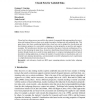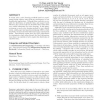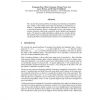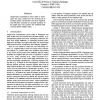109
click to vote
JMLR
2008
15 years 17 days ago
2008
Closed sets have been proven successful in the context of compacted data representation for association rule learning. However, their use is mainly descriptive, dealing only with ...
92
Voted
CORR
2006
Springer
15 years 19 days ago
2006
Springer
We consider semi-supervised classification when part of the available data is unlabeled. These unlabeled data can be useful for the classification problem when we make an assumpti...
117
Voted
SIGIR
2010
ACM
15 years 24 days ago
2010
ACM
In recent years, active learning methods based on experimental design achieve state-of-the-art performance in text classification applications. Although these methods can exploit ...
120
click to vote
DAGM
2010
Springer
15 years 1 months ago
2010
Springer
Abstract. A successful approach to tracking is to on-line learn discriminative classifiers for the target objects. Although these trackingby-detection approaches are usually fast a...
107
click to vote
AAAI
1998
15 years 2 months ago
1998
In many important text classification problems, acquiring class labels for training documents is costly, while gathering large quantities of unlabeled data is cheap. This paper sh...
110
click to vote
NIPS
2003
15 years 2 months ago
2003
We consider the general problem of learning from labeled and unlabeled data, which is often called semi-supervised learning or transductive inference. A principled approach to sem...
IJCAI
2003
15 years 2 months ago
2003
Single-Class Classification (SCC) seeks to distinguish one class of data from the universal set of multiple classes. We present a new SCC algorithm that efficiently computes an ac...
103
Voted
IJCAI
2003
15 years 2 months ago
2003
This paper investigates a new approach for training discriminant classifiers when only a small set of labeled data is available together with a large set of unlabeled data. This a...
105
click to vote
NIPS
2001
15 years 2 months ago
2001
This paper presents an unsupervised learning algorithm that can derive the probabilistic dependence structure of parts of an object (a moving human body in our examples) automatic...
95
Voted
NAACL
2001
15 years 2 months ago
2001
We present two methods for learning the structure of personal names from unlabeled data. The first simply uses a few implicit constraints governing this structure to gain a toehol...




